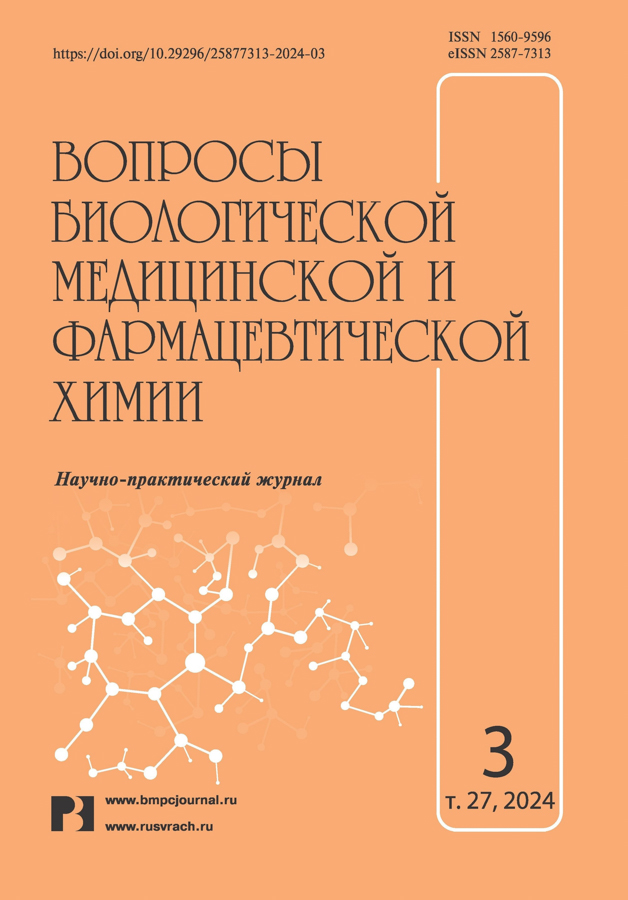Подбор методики изолирования Тиофана М из органов животных
- Авторы: Лигостаев А.В.1, Ивановская Е.А.1, Терентьева С.В.1, Пашкова Л.В.1, Жеребцова Е.Ю.1, Просенко О.И.2, Питухин М.П.3
-
Учреждения:
- Новосибирский государственный медицинский университет
- Новосибирский государственный педагогический университет
- Новосибирский институт органической химии им. Н.Н. Ворожцова СО РАН
- Выпуск: Том 27, № 3 (2024)
- Страницы: 41-48
- Раздел: Вопросы экспериментальной биологии и медицины
- URL: https://journals.eco-vector.com/1560-9596/article/view/629327
- DOI: https://doi.org/10.29296/25877313-2024-03-07
- ID: 629327
Цитировать
Полный текст
Аннотация
Введение. Важным подготовительным этапом сбора информации для регистрации нового лекарственного средства является изучение его фармакокинетических параметров в соответствии с требованиями надлежащей лабораторной практики. Подготовительный этап такого исследования заключается в подборе оптимальных условий пробоподготовки биологических объектов к определению в них испытуемого вещества.
Цель работы – подбор оптимальных условий пробоподготовки, включая значение рН экстрагента, а также изолирования Тиофана М из органов лабораторных животных (крыс) для его дальнейшего вольтамперометрического определения по разработанной ранее методике.
Материал и методы. Объектом исследования служила субстанция Тиофана М [додецил(3,5,-диметил-4-гидроксибензил)сульфида] – перспективное биологически активное соединение с антиоксидантными свойствами, разработанное на базе кафедры химии Новосибирского государственного педагогического университета совместно с НИИ химии антиоксидантов. Экспериментальные данные получены с использованием 5 крыс-самцов массой 350–380 г, которым вводили внутрижелудочно испытуемый образец Тиофана М в дозе 500 мг/кг в виде масляного раствора на оливковом масле.
Результаты. Общее количество полученных и исследованных образцов – 180. На основе полученных данных с их последующей статистической обработкой методом непрямых разностей, согласно Государственной фармакопее XIV издания, установили, что оптимальным условием для извлечения Тиофана М является однократная экстракция диэтиловым эфиром. Данный факт подтвержден результатами вольтамперометрического анализа. Показано, что наибольшее количество Тиофана М локализовано в мозге, сердце и легких (364,0±8,20, 332,0±16,47 и 275,0±25,40 мкг/г соответственно), в меньшем количестве Тиофан М обнаружен в почках, селезенке и печени (146,0±15,50, 81,0±8,66 и 56,0±14,53 мкг/г соответственно).
Выводы. Из всех проведенных методик изолирования Тиофана М из органов крыс выбрана методика с использованием в качестве экстрагента эфира диэтилового, которая давала стабильные результаты, благодаря максимальному извлечению вещества.
Ключевые слова
Полный текст
Об авторах
А. В. Лигостаев
Новосибирский государственный медицинский университет
Автор, ответственный за переписку.
Email: arbi.83@mail.ru
к.фарм.н.
Россия, НовосибирскЕ. А. Ивановская
Новосибирский государственный медицинский университет
Email: arbi.83@mail.ru
д.фарм.н., профессор
Россия, НовосибирскС. В. Терентьева
Новосибирский государственный медицинский университет
Email: arbi.83@mail.ru
д.фарм.н., доцент
Россия, НовосибирскЛ. В. Пашкова
Новосибирский государственный медицинский университет
Email: arbi.83@mail.ru
ст. преподаватель
Россия, НовосибирскЕ. Ю. Жеребцова
Новосибирский государственный медицинский университет
Email: arbi.83@mail.ru
ст. преподаватель
Россия, НовосибирскО. И. Просенко
Новосибирский государственный педагогический университет
Email: arbi.83@mail.ru
к.х.н., доцент
Россия, НовосибирскМ. П. Питухин
Новосибирский институт органической химии им. Н.Н. Ворожцова СО РАН
Email: arbi.83@mail.ru
аспирант
Россия, НовосибирскСписок литературы
- Шинко Т.Г., Терентьева С.В., Ивановская Е.А. и др. Разработка биоаналитической методики определения нового антиоксиданта вольтамперометрическим методом. Фармация. 2021; 70(8): 12‒18.
- Смольякова В.И., Плотников М.Б., Чернышева Г.А. и др. Антиоксидантные эффекты тиофана при экспериментальном поражении печени тетрахлорметаном. Бюллетень сибирской медицины. 2010; 5: 98–101.
- Бахтина И.А., Антипьева Е.В., Просенко А.Е. Влияние антиоксиданта «тиофан» на параметры антиокислительного стресса при ишемической болезни сердца. Бюллетень СО РАМН. 2000; 3: 24–29.
- Меньщикова Е.Б., Ланкин В.З., Кандалинцева Н.В. Фенольные антиоксиданты в биологии и медицине. Saarbrucken: LAP LAMBERT Academic Publishing, 2012; 488 с.
- Трегубова И.А., Косолапов В.А., Спасов А.А. Антиоксиданты: современное состояние и перспективы. Успехи физиологических наук. 2012; 43(1): 7594.
- Neha K., Haider M., Pathak A., Yar M.S. Medicinal prospects of antioxidants: A review. European Journal of Medicinal Chemistry. 2019; 178: 687704.
- Xu X., Liu A., Hu S. et al. Synthetic phenolic antioxidants: Metabolism, hazards and mechanism of action. Text: electronic. Food Chemistry. 2021; 353: 129488. URL: https://www.sciencedirect.com/science/article/abs/pii/S0308814621004945?via%3Dihub (date of access: 20.01.2023).
- Dastmalchi N., Baradaran B., Latifi-Navid S. Antioxidants with two faces toward cancer Text: electronic. Life Sciences. 2020; 258: 118186. URL: https://www.sciencedire-ct.com/science/artic-le/abs/pii/S0024320520309383?via%3Dihub (date of access 20.01.2023).
- Моров П.В. Стрелова О.Ю., Куклин В.Н. Разработка методик изолирования лекарственных веществ из крови в рамках реализации Приказа МЗ РФ №933н. Journal of Siberian Medical Sciences. 2020; 2: 30–41.
- Bioanalytical Method Validation. Guidance for Industry. Text: electronic. Department of Health and Human Services FDA. 2018. URL: https://www.fda.gov/files/drugs/published/Bioanalytical-Method-Validation-Guidance-for-Industry.pdf (date of access: 15.02.2023).
- Guideline on bioanalytical method validation. Text: electronic. European Medicines Agency. 2011. URL: https://www.ema.europa.eu/en/documents/scientific-guideline/guideline-bioanalytical-method-validation_en.pdf (date of access: 15.02.2023).
- Яичков И.И., Джурков Ю.А., Шитов Л.Н. Основные ошибки в аналитической части исследований биоэквивалентности и фармакокинетики. Медицинская этика. 2018; 6(1): 33–38.
- Шинко Т.Г., Терентьева С.В., Ягунов С.Е. и др. Разработка методик количественного определения нового антиоксиданта додецил(3,5-диметил-4-гидроксибензил)сульфида. Медицина. 2021; 9(3): 99–110.
- Лейтес Е.А., Анисимова Л.С., Катюхин В.Е. Определение органических сульфидов методом инверсионной вольтамперометрии. Известия Алтайского государственного университета. 1998; 1: 82–84.
- Гладышев В.П., Ковалева С.В., Черемухина Н.М. Определение сульфид-ионов методов вольтамперометрии. Журнал аналитической химии. 2004; 59(8): 839‒842.
- Mirceski V., Komorsky-Lovric S., Lovric M. Square-Wave Voltammetry. Theory and application. Leipzig: Springer-Verlag Berlin Heidelberg, 2007: 201.
- Государственная фармакопея Российской Федерации XIV издания: в 4 т. Т. 1. Режим доступа: https://docs.rucml.ru/feml/pharma/v14/vol1/ (дата обращения: 06.03.2023).
- Крамаренко В.Ф. Токсикологическая химия. Киев: Выща школа, 1989; 447 с.
- Вергейчик Т.Х. Токсикологическая химия. М.: 2009; 400 с.
- Справочник биохимика: пер. с англ. Р. Досон, Д. Эллиот, У. Эллиот, К. Джонс. Москва: Мир. 1991; 544 с.
Дополнительные файлы













